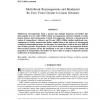Free Online Productivity Tools
i2Speak
i2Symbol
i2OCR
iTex2Img
iWeb2Print
iWeb2Shot
i2Type
iPdf2Split
iPdf2Merge
i2Bopomofo
i2Arabic
i2Style
i2Image
i2PDF
iLatex2Rtf
Sci2ools
JCB
2008
2008
Multi-Break Rearrangements and Breakpoint Re-Uses: From Circular to Linear Genomes
Multi-break rearrangements break a genome into multiple fragments and further glue them together in a new order. While 2-break rearrangements represent standard reversals, fusions, fissions, and translocations, 3-break rearrangements represent a natural generalization of transpositions. Alekseyev and Pevzner (2007a, 2008a) studied multi-break rearrangements in circular genomes and further applied them to the analysis of chromosomal evolution in mammalian genomes. In this paper, we extend these results to the more difficult case of linear genomes. In particular, we give lower bounds for the rearrangement distance between linear genomes and for the breakpoint re-use rate as functions of the number and proportion of transpositions. We further use these results to analyze comparative genomic architecture of mammalian genomes. Key words: algorithms, combinatorics, computational molecular biology, evolution, genomic rearrangements.
| Added | 13 Dec 2010 |
| Updated | 13 Dec 2010 |
| Type | Journal |
| Year | 2008 |
| Where | JCB |
| Authors | Max A. Alekseyev |
Comments (0)

